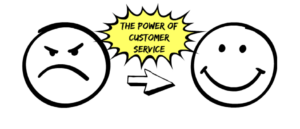
Your call (isn’t) important to us and will(not) be attended to shortly!

Distilled, actionable insights on branding, innovation, creativity, leadership, soul enhancement, marketing, advertising and design thinking

A legacy approach might be stifling you, without you even realising it.Best practices may not be that best(or better) at all. In fact there is scope to abandon best practice as the ‘ practice ‘ as it used to exist has changed altogether.
Your current marketing and customer strategies may unknowingly be rooted in old patterns. It may be time for a change.
The purpose of business—creating a customer—and your customers—at a human level—aren’t changing. That, irrespective of all the tectonic shifts happening around them.
But for many businesses, it’s time to make a change toward having a deep understanding of their true purpose and their customers.
The terms consumer and customer are often used interchangeably but they signify very different relationships. Etymologically, consumer stems from a word that means “one who squanders or wastes,” whereas customer stems from a word meaning “a person with whom one has dealings,” with the implication that it is an ongoing relationship.
As Stanley Marcus, of Neiman Marcus, wrote, “Customers are people; consumers are statistics.”
Marketing isn’t about selling to the customer; that’s a byproduct. As the legendary Peter Drucker observed, “The aim of marketing is to make selling superfluous. The aim of marketing is to know and understand the customer so well that the product or service fits him and sells itself. Ideally, marketing should result in a customer who is ready to buy.”
It’s the time to break old tendencies. Its the time to be aware, to rebel, to kill old habits and to seek change.
Not changing is a default tendency. Change the default settings!
“. It’s no longer exceptional for stuff (anything, everything ) to work. Which means the bar for ” standing out ” has risen dramatically.
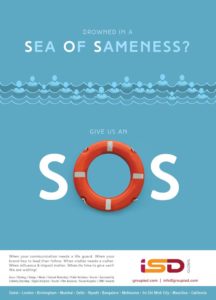



Marketing the New ‘Terms’ of Endearment
Over the years, tried and oft used terms in the world of business and marketing have transcended convention. We seem to be in a perennial state of having to come to terms with these terms. Here is the term sheet on that.
Brand Owners, Advertisers and Marketers were once cosy with ‘ Mass Market ‘. Try and reach the maximum audience numbers through mass media. A lot of the times it was about Spray and Pray. Mass Market transitioned to ‘ Mass Customisation ‘ which went beyond one size fits all to one size fitting some. With the advent of Artificial Intelligence, Machine Learning and Data Science, we are now in an era of the ‘ Customer Segment of One ‘, where one individual as an audience is targeted with high degree of precision and success.
The disclaimers have been turned on its head as well. What used to be common place was a term going as ‘ Caveat Emptor ‘ which essentially was to say buyers beware. The entire onus and risk on buying a product or service was all on the buyer/end user. Now, in an over commoditised world, where we have moved on from push and control to pull and engage, where top down has given way to bottom up marketing, what is evident is ‘ Caveat Venditor ‘, where the accountability and responsibility rests fully on the seller. The wheel has gone a full circle.
Not until long ago, brands and their marketing plans were etched out keeping demographic groups in mind. A pre decided age group with a certain buyer persona was carved out and communication was created to influence and impact that community. The universe has changed dramatically. Brand marketers have now started addressing mindsets which throws conventional wisdom out of the window. As they have now begun to chant, RIP Demographics!
Consumer aspirations have taken a twist as well. Yesteryears we had all marketing and communication created to induce brand ownership. With so much millennial consumption happening, the entire paradigm has now shifted to owning experiences. The new brand mantra for marketers is CeX(Customer Experience) and the City. Ownership is passe, experience is the new aspiration.
Remember those days when the quintessential manna from heaven was ‘ brand loyalty ‘. Coveted, treasured, revered. Loyalty was royalty. In an era of surplus of goods, information, choices, services and a deficit of trust, attention and resources, ‘ customer infidelity ‘ has replaced loyalty. Cheaper, better, faster? Here we shift loyalties!
We were just coming to terms with the ‘ knowledge economy ‘ as it moved on from the ‘ Industrial Economy ‘and before we knew it we were bang in the middle of the ‘sharing/collaborative economy‘. The dust had hardly settled on that and now the entire attention is rooted on the ‘ attention economy ‘. In an age of perennial distraction, attention is the new premium.
Since advent of marketing, and the quest for differentiation, the narrative has revolved around a USP(Unique Selling Proposition). That feature or benefit which makes your brand distinct or unique from other competitors in the eco system.Then came the not so holy communion onslaught- the SOS- Sea of Sameness. Nothing unique, nothing distinct, the herd mentality, the also ran, the me too. Which prompted our research at ISD Global to discover what we have come to label as UFP- Unique Feelings Proposition– where state of the heart is what brands are appealing to win trust, loyalty, mind and wallet space.
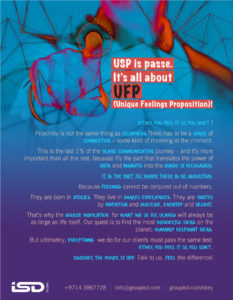
Am sure we will have more to chew on as the intersection of consumer behaviour, rapid evolution of technology and the ever changing socio economic landscape will throw up more perspectives that we have to come to terms with. Till then, au revoir.
ENDS
www.groupisd.com/story
www.brandknewmag.com
I have been at the crossroads the past few weeks wondering what is the biggest marketing con job in the past few decades. After careful distilling, zeroed in on these three:-
Red Wine: With all of it’s anti oxidant properties spiel, filled enough guilt to ensure your heart reaches out to it. As for me, not so much the Cabernet Sauvignon and Syrah. I prefer Red Wine of the Neil Diamond variety.
Dhanteras: The compelling quest amongst many of us Indians for heavy metal- read ‘ jewellery ‘. The DAY to MUST buy, or else all sanctity will break loose. To me, if it’s heavy metal, give me Iron Maiden or Jethro Tull or Scorpion, any day.My Doors are open.
Valentine’s Day: 1 Day in the year when we get a Notification to drop everything else and express love.A reminder that there is a remainder. Do you see RED with this? What happened the other 364 Days? In an always on world, shouldn’t love be always on?
Take your pick. Or if you are piqued, feel free to disagree.
Just as I finish writing this post my good friend Goswami called from Calcutta wishing Happy Ballantine’s Day! Did not want to dampen his spirit and tell him that my taste lies elsewhere!
ENDS
www.groupisd.com
www.brandknewmag.com
Technology and Wisdom: In marketing, the twain can’t seem to meet!
To say that we are at the very forefront of cutting edge technology would be an understatement. Considering all the spectacular advances we see today in space travel, driverless cars, artificial intelligence, IOT, robotics, digital health, augmented reality, laser guided missiles etc, technology surely has motored along at more than a furious clip. Technology is ubiquitous, omni present, in the face and as they say, ‘ always on ‘.
Wisdom on the other hand is very much under the radar not because it cannot be droned up into the spotlight but there seems to be a tangible scarcity of it around. Most definitely in marketing.
In marketing, technology and wisdom are at two opposite ends of the spectrum. And, unlike magnetic forces, these opposites don’t attract. On the contrary, they repel. Technology is always moving in linear progression. Wisdom, on the other hand, with all the associated ammunition of insights, experience, maturity, just does not. Cannot.
Not all technology is the domain of the young and not all wisdom comes with age. But, as a general rule, tech is the territory of youth, wisdom the territory of maturity. Though there is strong perception that technology equates wisdom, nothing that we see today in the world of marketing or advertising at least backs the argument even remotely. We are in an era of ‘ technology overload ‘ that causes ad frauds(US$16 Billion), intrusion of customer privacy, manipulation of public opinion, colossal wastage etc etc. And there is no wisdom in that.
We seem to have moved on from what the very wise advertising greats of the past including William Bernbach, Howard Gossage etc preached and practiced. With a great degree of success. Without any technology at their disposal.
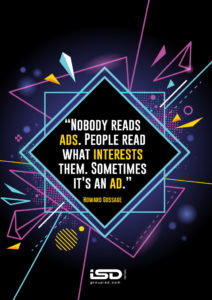
Technology digs into collective bias. What is called for is a balance of technology with the scaffolding of wisdom, without which, sauce for the goose is not exactly sauce for the gander!
As T.S Eliot said ‘ Where is the wisdom we have lost in all the knowledge? Where is the knowledge that we have lost in all the information? And where is the life that we have lost in living? ”
ENDS
Image: ISD Global
www.groupisd.com
www.brandknewmag.com
Does this article caption seem like sacrilege? Especially in the context of all the cacophony of narratives that float around viz Customer Service, Customer Delight, Customer Centricity, Customer Experience, Customer Journey...and all of that and more.
Over time, we have transgressed(not so effortlessly) from mass to mass customisation to personalisation to customer segment of one. And somewhere in between there is the Long Tail effect as well that encourages more granularity when it comes to addressing customers.
The phrase “ The customer is always right ” was originally coined in 1909 by Harry Gordon Selfridge, the founder of Selfridge’s department store in London.Business was different, expectations were certainly so and organised retail was only at the embryonic stage. This line is typically used by businesses to convince customers that they will get good service at this company and convince employees to give customers good service.
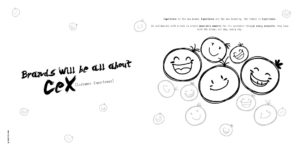
Of course, there are plenty of examples of bad employees giving lousy customer service( the United Airlines incident last year involving a passenger last year stands out like a sore thumb) but trying to solve this by declaring the customer “always right” is counter-productive.
CEO Hal Rosenbluth(owner of Rosenbluth Corporate Travel, since acquired by American Express) wrote an excellent book about their approach called Put The Customer Second – Put your people first and watch’em kick butt. Rosenbluth argues that when you put the employees first, they put the customers first. It’s a chain reaction, often overlooked by organisations and brands.
In his book Customer Centricity, Peter Fader(Marketing Professor at Wharton & Co-Director,The Wharton Customer Analytics Initiative) encourages business owners to focus on the customers who matter most: “Not all customers deserve your company’s best efforts. And despite what the old adage says, the customer is most definitely not always right. Because in the world of customer centricity, there are good customers…and then there is everybody else.”
To borrow the experience that Tim Ferris(author of the wildly popular The Four Hour Work Week book) where he realised he was spending far too much time attending to customers who were contributing very little to revenues but causing high amount of stress, only to recalibrate his energies and attention to customers that warranted it best.
Haven’t we heard this before: “The customer is always right, except when they’re wrong—and then, it’s our fault”.
A more balanced way of looking at it would be to respect the customer, as it’s not about who’s right; it’s about what’s best for your company and the customer together. It takes two to tango.
Another example was when Toblerone changed the shape of their iconic chocolate bars, customers went absolutely bananas. It wasn’t that the new shape of the bars was bad, per se. It was just different, and people HATE different. Customers like to maintain the norm.The status quo, be in the comfort zone..
When you make changes in your business, you will probably get some initial backlash, even if the change that you have made, is for the better. If you have the attitude that the customer is always right, you’ll never make healthy improvements to your business because the possibility of bad customer feedback will paralyse you.
Needless to say we all need to strive for excellent customer service, or delight or experience as the case may be. But, adopting a ‘ Customer is always right ‘ policy can end up actually hurting your business. You kill employee morale, empower rude customers, slow down innovation, and even create unhappy experiences for other customers.
A much better strategy would be to empower your team to make the right decisions. And, that would translate to” The Right Customer is Always Right “. That’s a much better place to be.
ENDS
Image: ISD Global
www.groupisd.com
www.brandknewmag.com
A lot of us are now on the drawing board mapping out ways to get better in 2018. The fundamentals are not going to change- reach, connect,engage, influence, transact and all of that- but what could we do to better stimulate the landscape as we get set to welcome and take on the New Year. Here’s a partial(and ever evolving list):-

a) A new BHAG of tricks: Nothing brings together a team like a BHAG — a Big Hairy Aggressive Goal —without enough time to deliver it. Backs to the wall brings out the best in us!
b) Am not alluding to the fact of disrespecting the organisation chart but don’t obsess over it on paper.Instead, get the right people, the right goals and vitally, the right trust in place.
c) And for all the HeRoines and HeRoes in HR, recruit with an immersion, not just an interview. Align passion with goals.Basic, yes! Hire marketing leaders with general management skills to ensure results exceed individual contribution.
d) When things are working well, that is the best time to deconstruct your strategy and try new things.
e) If you are in a new category where your customers need a lot of education and support, your organisation needs to be built around education first and products second.
f) Extend your approach to marketing beyond “getting a message out there”; focus on building trust.
g) Don’t overcomplicate marketing. At the end of the day, it’s still marketing: Market Research, Content, Sales enablement, Awareness, Demand generation, Partnerships, Customer retention.Customer advocacy.
h) When you’re the underdog in your industry, hire people with the DNA to creatively leapfrog the competition, not follow the industry norms. You need to have your Purple Cow(fantastic book by Seth Godin).
i) Own marketing across the organisation. Don’t be afraid to integrate marketers into other parts of the organisation, but always have at least a dotted line back to marketing.
j) Don’t be afraid of data and machine learning. The time is now to put all that data to use to solve the problems humans simply can’t and further the industry. The key is to leverage them as part of your team, not external resources. Data is the (K)new oil as they say! The transition even amongst large enterprises hitherto involved ion B 2 B marketing is happening towards a B to I space(Business to Individual).
k) The best marketing combines data and storytelling. It gives you a way to appeal to the emotional side of people. The Unique Feelings Proposition is what brands need to go after!
l) The future of marketing is in the CeX(Customer Experience). Success comes from knowing your consumers’ passions, being innovative in the way you engage them and having a team that collaborates across all aspects of the customer experience delivery. For consumers, the thrill and purpose of experience has replaced the earlier compulsion for ownership. So ride the opportunity.
m) Marketers will know that The Future of Advertising will be a thing of the past. So, re invent, re engineer, re boot and re calibrate! There is a new customer segment: the Customer Segment of 1. Get ready to reach out to them. Address mindsets, not demographics!
n) As we are all agreeing these days, digital is just as much marketing as marketing is digital. So the two roles have combined, and how! It’s a tell, tell, tell, digitell world.
o) Brands and marketers will recognise the immense power of Transparency and how consumers warm up to brands who are not afraid to stand in their own truth. In a Post Truth world, The Future is Transparency!
Marketing has the power, and responsibility, to inspire the whole company, not just customers. Marketing also has the power to be so much more than the “make it pretty” department.It has the imperative to inspire everyone in the company, not just the people who touch the product.So, let us know our rockets from our launch pads.
For inspiring quotes and actionable intelligence from brand owners and marketing champions, please check this link http://groupisd.com/isd-brochure/
ENDS
www.groupisd.com
www.brandknewmag.com
Image Courtsey: Search Engine Journal